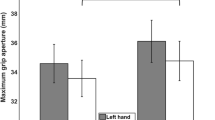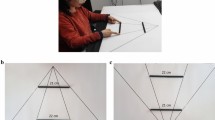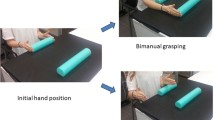Abstract
To find points on the surface of an object that ensure a stable grasp, it would be most effective to employ one area in one cortical hemisphere. But grasping the object with both hands requires control through both hemispheres. To better understand the control mechanisms underlying this “bimanual grasping”, here we examined how the two hemispheres coordinate their control processes for bimanual grasping depending on visual field. We asked if bimanual grasping involves both visual fields equally or one more than the other. To test this, participants fixated either to the left or right of an object and then grasped or pushed it off a pedestal. We found that when participants grasped the object in the right visual field, maximum grip aperture (MGA) was larger and more variable, and participants were slower to react and to show MGA compared to when they grasped the object in the left visual field. In contrast, when participants pushed the object we observed no comparable visual field effects. These results suggest that grasping with both hands, specifically the computation of grasp points on the object, predominantly involves the right hemisphere. Our study provides new insights into the interactions of the two hemispheres for grasping.




Similar content being viewed by others
References
Baas U, de Haan B, Grassli T, Karnath H-O, Mueri R, Perrig WJ, Wurtz P, Gutbrod K (2011) Personal neglect—a disorder of body representation? Neuropsychologia 49:898–905
Begliomini C, Wall MB, Smith AT, Castiello U (2007) Differential cortical activity for precision and whole-hand visually guided grasping in humans. Eur J Neurosci 25:1245–1252
Binkofski F, Buccino G (2006) The role of ventral premotor cortex in action execution and action understanding. J Physiol (Paris) 99:396–406
Binkofski F, Dohle C, Phil M, Posse S, Stephan KM, Hefter H, Seitz J, Freund HJ (1998) Human anterior intraparietal areas subserves prehension: a combined lesion and functional MRI activation study. Neurology 50:1253–1259
Blake A (1992) Computational modelling of hand-eye coordination. Philos Trans R Soc London [Biol] 337:351–360
Blake A, Taylor M, Cox, A (1993) Grasping visual symmetry. In: Proceedings of the fourth international conference on computer vision. International conference on computer vision, Berlin
Blanke O, Ortigue S, Landis T, Seeck M (2002) Stimulating illusory own-body perceptions. Nature 419:269–270
Brainard DH (1997) The psychophysics toolbox. Spatial Vis 10:433–436
Brinkman J, Kuypers MGJM (1972) Split-brain monkeys: cerebral control of ipsilateral arm, hand, and finger movements. Science 176:536–539
Castiello U (2005) The neuroscience of grasping. Nat Rev Neurosci 6:726–736
Castiello U, Bennett KMB, Stelmach GE (1993) The bilateral reach to grasp movement. Behav Brain Res 56:43–57
Corbetta D, Thelen E (1996) The developmental origins of bimanual coordination: a dynamic perspective. J Exp Psychol Hum Percept Perform 22:502–522
Cornelissen FW, Peters EM, Palmer J (2002) The Eyelink toolbox: eye tracking with MATLAB and the psychophysic toolbox. Behav Res Meth Ins C 34:613–617
Culham JC, Valyear KF (2006) Human parietal cortex in action. Curr Opin Neurobiol 16:205–212
Culham J, Danckert SL, DeSouza JFX, Gati JS, Menen RS, Goodale MA (2003) Visually guided grasping produces fMRI activation in dorsal but not ventral stream brain areas. Exp Brain Res 153:180–189
Davare M, Andres M, Clerget E, Thonnard J-L, Olivier E (2007) Temporal dissociation between hand shaping and grip force scaling in the anterior intraparietal area. J Neurosci 27:3974–3980
Devinsky O, D’Esposito M (2003) Neurology of Cognitive and Behavioural Disorders. Oxford University Press, New York
Dohle C, Ostermann G, Hefter H, Freund H-J (2000) Different coupling for the reach and grasp components in bimanual prehension movements. NeuroReport 11:3787–3791
Duque J, Davare M, Delaunay L, Jacob B, Saur R, Hummel F, Hemoye L, Rossion B, Olivier E (2009) Monitoring coordination during bimanual movements: where is the mastermind? J Cognit Neurosci 22:526–542
Ehrsson HH, Fagergren A, Jonsson T, Westling G, Johansson RS, Forssberg H (2000) Cortical activity in precision- versus power-grip tasks: an fMRI study. J Neurophysiol 83:528–536
Frey SH, Vintonb D, Norlund R, Grafton ST (2005) Cortical topography of human anterior intraparietal cortex active during visually guided grasping. Cognit Brain Res 23:397–405
Galletti C, Kutz DF, Gamberini M, Breveglieri R, Fattori P (2003) Role of the medial parieto-occipital cortex in the control of reaching and grasping movements. Exp Brain Res 153:158–170
Glover S, Miall RC, Rushworth MFS (2005) Parietal rTMS disrupts the initiation but not the execution of on-line adjustments to a perturbation of object size. J Cog Neurosci 17:124–136
Gonzalez CL, Goodale MA (2009) Hand preference for precision grasping predicts language lateralization. Neuropsychologia 47:3182–3189
Gonzalez CLR, Ganel T, Goodale MA (2006) Hemispheric specialization for the visual control of action is independent of handedness. J Neurophysiol 95:3496–3501
Gonzalez CLR, Ganel T, Whitwell RL, Morrissey B, Goodale MA (2008) Practice makes perfect, but only with the right hand: sensitivity to perceptual illusions with awkward grasps decreases with practice in the right but not the left hand. Neuropsychologia 46:624–631
Goodale MA, Meenan JP, Bülthoff HH, Nicolle DA, Murphy KJ, Racicot CI (1994) Separate neural pathways for the visual analysis of object shape in perception and prehension. Curr Biol 4:604–610
Grafton ST (2010) The cognitive neuroscience of prehension: recent developments. Exp Brain Res 204:475–491
Grol MJ, Majdandžić J, Stephan KE, Verhagen L, Dijkerman HC, Bekkering H, Verstraten FAJ, Toni I (2007) Parieto-frontal connectivity during visually guided grasping. J Neurosci 27:11877–11887
Harris CM, Wolpert DM (1998) Signal-dependent noise determines motor planning. Nature 394:780–784
Hughes CML, Franz EA (2008) Goal-related planning constraints in bimanual grasping and placing of objects. Exp Brain Res 188:541–550
Jackson GM, Jackson SR, Kritikos A (1999) Attention for action: coordinating bimanual reach-to-grasp movements. Br J Psychol 90:247–270
Jeannerod M (1981) Intersegmental coordination during reaching at natural visual objects. In: Long J, Baddeley A (eds) Attention and performance IX. Erlbaum, Hillsdale
Keefe BD, Hibbard PB, Watt SJ (2011) Depth-cue integration in grasp programming: no evidence for a binocular specialism. Neuropsychologia 49:1246–1257
Lederman SJ, Wing AM (2003) Perceptual judgement, grasp point selection and object symmetry. Exp Brain Res 152:156–165
Luppino G, Rizzolatti G (2000) The organization of the frontal motor cortex. News Physiol Sci 15:219–224
Macaluso E, Frith CD, Driver J (2002) Crossmodal spatial influences of touch on extrastriate visual areas take current gaze direction into account. Neuron 34:647–658
Murata A, Gallese V, Lupino G, Kaseda M, Sakata H (2000) Selectivity for the shape, size, and orientation of objects for grasping in neurons of monkey parietal area AIP. J Neurophysiol 83:2580–2601
Napier JR (1956) The prehensile movements of the human hand. J Bone Jt Surg 38:902–913
Ochiai T, Mushiake H, Tanji J (2005) Involvement of the ventral premotor cortex in controlling image motion of the hand during performance of a target-capturing task. Cereb Cortex 15:929–937
Oldfield RC (1971) The assessment and analysis of handedness: the Edinburgh inventory. Neuropsychologia 9:97–113
Olivier E, Davare M, Andres M, Fadiga L (2007) Precision grasping in humans: from motor control to cognition. Curr Opin Neurobiol 17:644–648
Park JH, Shea CH (2002) Effector independence. J Motor Behav 34:253–270
Pelli DG (1997) The VideoToolbox software for visual psychophysics. Transforming numbers into movies. Spatial Vis 10:437–442
Rice NJ, Tunik E, Grafton ST (2006) The anterior intraparietal sulculs mediates grasp execution independent of requirement to update: new insights from transcranial magnetic stimulation. J Neurosci 26:8176–8182
Rice NJ, Tunik E, Cross ES, Grafton ST (2007) On-line grasp control is mediated by the contralateral hemisphere. Brain Res 1175:76–84
Ringo JL, Doty RW, Demeter S, Simard PY (1994) Time is of the essence: a conjecture that hemispheric specialization arises from inter-hemispheric conduction delay. Cereb Cortex 4:331–343
Rizzolatti G, Craighero L (2004) The mirror-neuron system. Annu Rev Neurosci 27:169–192
Rizzolatti G, Fadiga L, Gallese V, Fogassi L (1996) Premotor cortex and the recognition of motor actions. Cognit Brain Res 3:131–141
Rochat P (1989) Object manipulation and exploration in 2- to 5-month-old infants. Dev Psychol 25:871–884
Rochat P (1993) Hand-mouth coordination in the newborn: Morphology, determinants, and early development of basic act. In: Savelsbergh GJP (ed) The Development of Coordination in Infancy. Elsevier Science Publishers, North Holland
Rushworth MF, Johansen-Berg H, Göbel SM, Devlin JT (2003) The left parietal and premotor cortices: motor attention and selection. Neuroimage 20:89–100
Sakata H, Taira M (1994) Parietal control of hand action. Curr Opin Neurobiol 4:847–856
Sakata H, Taira M, Murata A, Gallese V, Tanaka Y, Shikata E, Kusunoki M (1996) Parietal visual neurons coding three-dimensional characteristics of objects and their relation to hand action. In: Their P, Karnath HO (eds) Parietal lobe contributions to orientation in 3D space. Springer, New York
Schlicht EJ, Schrater PR (2007) Effects of visual uncertainty on grasping movements. Exp Brain Res 182:47–57
Siddiqui A (1995) Object size as a determinant of grasping in infancy. J Genet Psychol 156:345–358
Singh VW, Stojanoski B, Le A, Niemeier M (2011) Spatial frequency-specific effects on the attentional bias: evidence for two attentional systems. Cortex 47:547–556
Smeets JBJ, Brenner E (1999) A new view on grasping. Mot Control 3:237–271
Smeets JBJ, Brenner E (2001) Independent movements of the digits in grasping. Exp Brain Res 139:92–100
Swinnen SP (2002) Intermanual coordination: from behavioural principles to neural-network interactions. Nat Rev Neurosci 3:350–361
Tanné J, Boussaoud D, Boyer-Zeller N, Rouiller EM (1995) Direct visual pathways for reaching movements in the macaque monkey. NeuroReport 7:267–272
Tresilian JR, Stelmach GE (1997) Common organization for unimanual and bimanual reach-to-grasp tasks. Exp Brain Res 115:283–299
Tunik E, Frey SH, Grafton ST (2005) Virtual lesions of the anterior intraparietal area disrupt goal-dependent on-line adjustments of grasp. Nat Neurosci 8:505–511
Tunik E, Ortigue S, Adamovich SV, Grafton ST (2008) Differential recruitment of anterior intraparietal sulcus and superior parietal lobule during visually guided grasping revealed by electrical neuroimaging. J Neurosci 28:13615–13620
Umiltà C (1994) The Simon effect: introductory remarks. J Psychol Res 56:127–129
Vangheluwe S, Suy E, Wenderoth N, Swinnen SP (2006) Learning and transfer of bimanual multifrequency patterns: effector-independent and effector-specific levels of movement representation. Exp Brain Res 170:543–554
Whishaw IQ, Coles BLK (1996) Varieties of paw and digit movement during spontaneous food handling in rat: postures, bimanual coordination, preferences, and the effects of forelimb cortex lesions. Behav Brain Res 77:135–148
Author information
Authors and Affiliations
Corresponding author
Rights and permissions
About this article
Cite this article
Le, A., Niemeier, M. A right hemisphere dominance for bimanual grasps. Exp Brain Res 224, 263–273 (2013). https://doi.org/10.1007/s00221-012-3309-z
Received:
Accepted:
Published:
Issue Date:
DOI: https://doi.org/10.1007/s00221-012-3309-z




